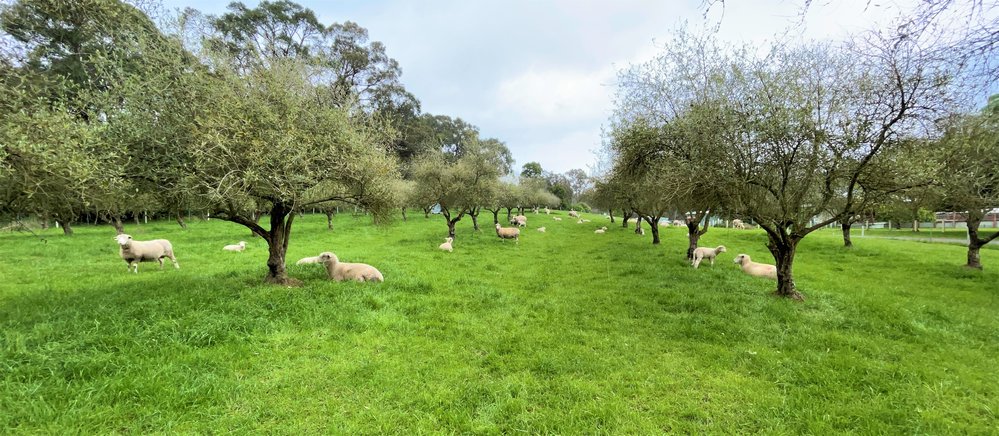Meatmaster for full bellies

It's an idyllic setting, with a babbling stream, an olive grove, lambs playing in the long pasture, not a care in the world.
But this farm, Thunder Hill Estate, is a work in progress that began five years ago, after nearly 20 years of neglect. The farm produces stud poll dorset sheep, as well as highly regarded meat. Located at the southern end of Victoria’s Yarra Valley, it has rich red and grey clay loam soils, the annual rainfall is in the order of 1400-1500mm, and the summers, on average hit the high 20’s to low 30’s.
It is not without its problems. Leaching of nutrients is a problem, pugging occurs near the creek edge, the soil tends to be acidic. It has its own microclimate, meaning that sometimes the forecast of rain doesn’t eventuate. When the Doherty family bought the property, it had been subdivided from a much larger farm 15 years earlier, a house plonked on it and not much thought given to drainage, soil health or even fencing.
The slow process of rehabilitating the farm has had its fair share of ups and downs, with a couple of paddocks failing to strike, in part due to the predicted rain not arriving, through to competition from wild grasses. In consultation with agronomist Rose Beyer, the Doherty’s have slowly transformed a third of the property into lush pasture, while another third is currently under renovation. The aim is to consistently put year-round high-quality pasture in front of stock to ensure they achieve maximum results.
“Producing stud level animals requires first class genetics,” says Simon. “Couple that with an excellent environment gives a superior phenotype, enabling those genetics to reach their full potential.
“I can already see after just a couple of years, the seed selections we’ve made have been the right choices. When the pasture is reaching the lambs’ bellies, I know we are on the right track.”
Soil health prior to renovation is of paramount importance to the Dohertys, and significant work was undertaken to prepare paddocks before full renovation. In 2017-18 summer crops were used to clean paddocks, followed by Autumn sown annual rye grasses that yielded moderate returns. The true success was the planting of a Barenbrug Meatmaster blend in Spring 2018 comprising tall fescue, annual and perennial ryegrasses, chicory, white and sub-clovers.
Simon says that he had tried other brands of annuals and mixes, but they just never seemed to take off, even with the same preparation as the Barenbrug mix. The Meatmaster blend ‘exploded’ and continues to provide the ME and CP (even in lean seasons) to allow the dorsets to excel.
“Compared to the paddocks that we are now renovating, you can see that the root system is far more developed, there is higher worm activity, cover density is higher and the pugging is less problematic. On average, poll dorset weight gain is in the order of 200-250gm per day – on the improved pastures we regularly see 400+, and often exceed 500-600.”
The hectare olive grove paddock currently stocks 60+ DSE (ewes with lambs afoot) for a 3-4 week rotation. The ewes were weighed at day 142 gestation, and at eight weeks post natal at marking are the same weight as result of the feed availability from the Meatmaster mix.
“The girls are a bit porky, they are putting a lot into their lambs as we’ve seen through the lamb average daily gain (ADG) identified at marking, and they’re still packing on the pounds – they’ll get a shock when they go onto maintenance,” Simon says.
The strength of the Meatmaster root structure has been a key benefit to the Dohertys, ‘we’re wet, very bloody wet and the pasture takes a pounding as a result of the high stocking rates. We’re particularly pleased with the root structure as it holds up well to the high rainfall and heavy sheep’. The lush length means that the forage distance is reduced, and it also provides protection for the lambs from foxes.
“The ewes and lambs will rotate through the Meatmaster roughly every three weeks until the lambs are weaned at 80 days, the lambs will continue to rotate through. Pasture is the cheapest and best form of feed, so once the property is fully renovated, we will have a clear idea of what the property’s true stocking capacity will be and how we look to our long term management and expected yield.
“If you can’t rear a good lamb on pasture like this, you must be doing something wrong.”
For more information on this pasture mix, see our Meatmaster product page or contact your local Barenbrug Territory Manager.

